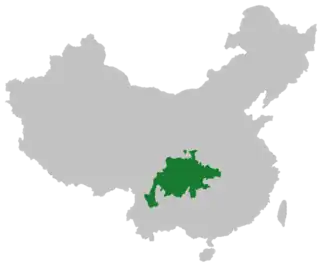Sichuanese characters (Chinese: 四川方言字; Sichuanese Pinyin: Si4cuan1 Fang1yan2zi4; pinyin: Sìchuān Fāngyánzì) are those Chinese characters used only in written Sichuanese. Sichuanese characters are often created as ideogrammatic compound characters (会意字) or phono-semantic compound characters (形声字).[1]
For example, in Sichuanese 𨈓 (Sichuanese Pinyin: nang1) means "thin", and it is created in ideogrammatic compounds as shown in the table below:
| 身(body) + 小(small) = 𨈓 |
| small body → thin |
Furthermore, 㧯 (Sichuanese Pinyin: nao3), which means 'to lift" in Sichuanese, is created as a phono-semantic compound character as shown in the table below:
| Determinative | Rebus | Compound |
|---|---|---|
| 扌 hand |
老 nao3 |
㧯 nao3 "to lift with hand" |
Examples
| Sichuanese character | Sichuanese Pinyin | meaning | Standard Chinese character with similar meaning |
|---|---|---|---|
| 𢭃 | dou4 | to compose | 拼 |
| 搣 | mie3 | to tear | 掰 |
| 𤆺 | kong3 | a local way to cook | none |
| 𠵫 | ngang3 | loud | 响 |
| 𨃅[2] | bai1 | lame | 瘸 |
| 𨈓 | nang1 | thin | 瘦 |
| 𤆵 | pa1 | soft | 软 |
| 朒 | ga3 | meat | 肉 |
| 奓 | za1 | open | 张 |
| 㮟 | ka1 or qia1 | to jam into | 塞 |
| 𣲩 | pa2 | a local quantifier | 滩 |
| 㞎 | ba3 | excrement | 屎 |
| 𧿨[2] | ban3 | to struggle | 挣扎 |
| 𧽤 | biao1 | to run fast | none |
| 𢱟 | can3 | to slap | 扇 |
| 𢲵 | cao4 | to stir | 搅 |
| 𡘧 | ka2 or qia2 | to step across | 跨 |
| 㩳 | song3 | to push | 推 |
| gu1 | to crouch | 蹲 | |
| | din1ga1 | small | 小 |
| 㥑 | ngou4 | to irritate, to become irritated, to become broken-hearted | 气 |
| 餈 | ci2 | a local dessert | none |
References
This article is issued from Wikipedia. The text is licensed under Creative Commons - Attribution - Sharealike. Additional terms may apply for the media files.
